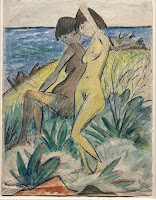What do Banksy and Basquiat have in common? Both their names start with a B, both are graffiti artists and both are famous with works reaching sky high prices. An exhibition at the Hirshhorn simply titled Basquiat X Banksy highlights the connection between the two artists who never met. Basquiat died in 1988 from a drug overdose and shadowy Banksy still very much alive, born in or near Bristol, of unknown birth date, graces buildings in various countries with his works. The latest, a series of animals, appeared in August 2024 closer to home in London. The exhibition scheduled to last more than a year is located in the basement, next to the gift shop.
From the outset, the star of the show is Basquiat with his giant black and white portrait photograph covering a whole wall at the entrance. Under his gaze, we progress along a maze of ropes set to control the crowd (absent today) as we catch a glimpse of "Downtown 81", a movie featuring Basquiat, displayed on a small television screen above our heads. In the first room, the attraction to Boy and Dog in a Johnnypump (1982) from Basquiat is irresistible with its splashes of Caribbean colors, exuberance and size (almost 14 feet wide and 8 feet high). The lively scene of a boy with his dog drenched by the water of an open fire hydrant is filled with fun and glee. Nearby, Banksy's Banksquiat. Boy and Dog in Stop and Search (2018) of similar size, provides an update to the black boy's story. The fiery colors have vanished and the scene of two white policemen on a pale grey background frisking the child is chilling. The scared dog is cowering in fear and the busy officers (one male and one female) fully equipped with manacles and radios surround the powerless boy, turning the playful activity into an unlawful trespassing. The two paintings made the news in recent years: the former was bought by the famous collector Ken Griffin in 2020 for 100 million, and the latter made a stir when it premiered illegally in the street outside the Barbican in 2017, in conjunction with an exhibition of Basquiat's work. Now protected by a sheet of Perspex, the piece has become a permanent resident on the outside wall of the Barbican. Its museal version made in 2018 on birch wood was auctioned at Phillips for almost 10 million in 2023. Following these two major pieces set in conversation for the first time in a museum, the twenty small framed drawings on paper or wood lent by the collector Larry Warsh require a close attention to be deciphered. Two cartoonish miniature self-portraits (?) with a caption "SAMO as an anti-art form", torn papers on cardboard covered with doodles and lists of random words lacking the poetry of the Surrealists who used the technique to stimulate their creativity, two small collages, one featuring Duchamp's portrait, the other, a warholian piece made with coupons of Chesterfield cigarette packages are accompanied in the last room by a collection of sketches and scribbles made from 1980 to 1983 at the height of Basquiat's short career. Samples of his visual language: crown, hood, car, train, anatomic parts, symbols, can be found in his larger works. Some visitors will inevitably mumble their thoughts: "My three years old can do that".
Basquiat's retrospective at the Musée d'Art Moderne de Paris in 2010 at the occasion of his fiftieth anniversary is still vivid in my memory, so are the show at the Ogden Museum of Southern Art during Prospect.3 and random encounters with his works. The display of framed scraps of paper from the graffiti artist who became a celebrated neo-expressionist lessens the impact of his legacy and would be better aimed at collectors, art historians and "art specialists" of all kind, than at the general public.
What about Banksy? Through his peculiar black-and-white stencil technique, the graffiti artist delivers witty political messages, often using appropriation like in this piece. His easy, catchy references, and recognizable design makes him a popular graffiti artist (with a knack for advertisement), a sort of Robin Hood of the art, offering million-dollar works for free to the passerby... works later acquired by celebrities for their private collection.
The wall texts feel somewhat inflated: "two of today's best known artists", verbose: "Banksy honors Basquiat's legacy while calling attention to the menace of systemic racism that impacted his life and still exists for people of color in many areas of the worlds today" and the curators' attempt to categorize the drawings under headings like "found objects" or "visual language", falls short of its goal.
Thanks to the collectors eager to share their treasures but it seems that the Hirshhorn Museum opened only its backdoor to the "two of today's best known artists".
photographs by the author:
Jean-Michel Basquiat: "Untitled (train)", 1981
"Untitled (Ego)", 1983
""Boy and Dog in a Johnnypump", 1982
Banksy: "Banksquiat. Boy and Dog in Stop and Search", 2018






























